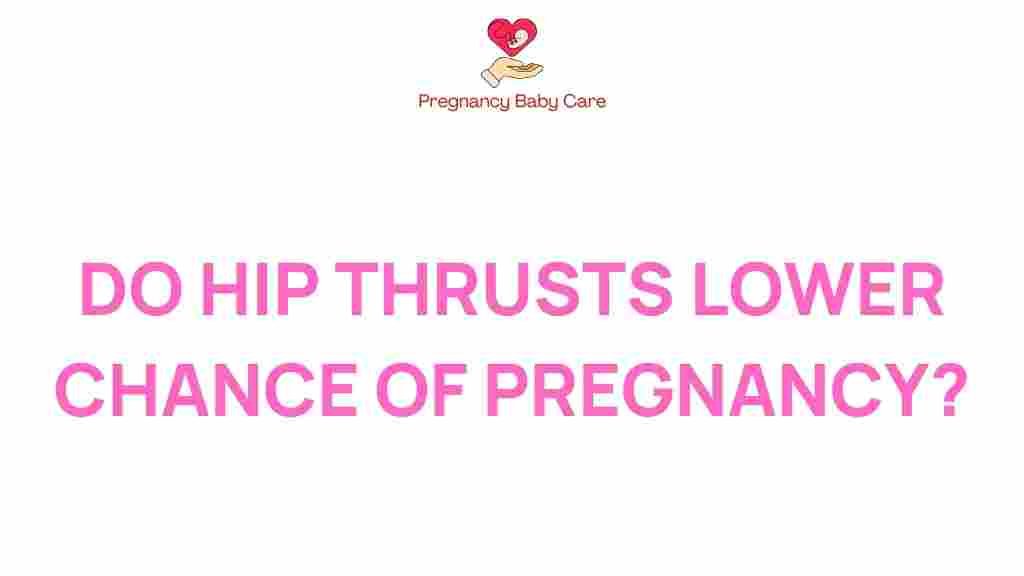Do Hip Thrusts Really Impact Your Pregnancy Chances?
When it comes to enhancing fertility and overall reproductive health, many women are exploring various methods to improve their chances of conception. Among these methods, exercise plays a pivotal role. One exercise that has gained popularity in recent years is the hip thrust. But do hip thrusts really impact your pregnancy chances? In this article, we will explore the relationship between hip thrusts, pregnancy, and women’s health, particularly focusing on fertility and strength training.
Understanding Hip Thrusts
Hip thrusts are a strength training exercise primarily targeting the glutes, hamstrings, and lower back. They are performed by resting your upper back on a bench and thrusting your hips upward while keeping your feet flat on the ground. This movement not only builds muscle but also improves overall stability and strength in the lower body. Here’s a quick breakdown of how to perform hip thrusts correctly:
- Start by sitting on the ground with your upper back against a bench.
- Roll a barbell over your hips, ensuring a comfortable position.
- Plant your feet flat on the ground, shoulder-width apart.
- Push through your heels to lift your hips toward the ceiling.
- Contract your glutes at the top, then lower back down.
The Link Between Exercise and Fertility
Regular exercise, including workouts that incorporate strength training, has been shown to have positive effects on women’s reproductive health. Here are some ways in which exercise can influence fertility:
- Weight Management: Maintaining a healthy weight can improve hormonal balance and increase the likelihood of conception.
- Improved Blood Flow: Exercise enhances circulation, delivering essential nutrients to reproductive organs.
- Stress Reduction: Regular physical activity helps lower stress levels, which can positively impact fertility.
- Hormonal Regulation: Exercise can help regulate hormones, making ovulation more predictable.
Hip Thrusts and Their Role in Women’s Health
Hip thrusts, specifically, can contribute to women’s health in several ways:
- Strengthening Core Muscles: A strong core supports overall body function, including reproductive health.
- Improving Posture: Good posture can positively influence pelvic alignment and health.
- Building Confidence: Strength training can enhance body image and confidence, which is beneficial for mental health during the fertility journey.
Do Hip Thrusts Directly Affect Pregnancy Chances?
While hip thrusts are a beneficial exercise for building strength and improving women’s health, it is essential to understand that they do not directly increase pregnancy chances. However, they can be a valuable part of a broader fitness routine that supports reproductive health. Here’s how:
- Enhanced Physical Fitness: Engaging in regular workouts, including hip thrusts, can improve overall fitness, which is crucial for a healthy pregnancy.
- Pelvic Floor Strength: Strengthening the glutes through hip thrusts can also support pelvic floor health, which is crucial during pregnancy and childbirth.
- Hormonal Balance: Regular exercise helps in the regulation of hormones, which is vital for ovulation and conception.
Step-by-Step Guide to Incorporating Hip Thrusts into Your Routine
If you are considering adding hip thrusts to your fitness regimen to support your reproductive health, follow these steps:
- Consult with a Healthcare Professional: Before starting any new exercise program, especially when trying to conceive, consult with your doctor or a qualified fitness professional.
- Start Gradually: If you’re new to strength training, start with bodyweight hip thrusts and gradually add resistance as you become more comfortable.
- Set a Schedule: Aim for at least two to three sessions per week focused on strength training, including hip thrusts.
- Combine with Other Exercises: Incorporate a variety of workouts that target different muscle groups, such as squats, lunges, and cardio exercises.
- Listen to Your Body: Pay attention to how your body responds to the exercises. If you feel discomfort, adjust your technique or consult a professional.
Common Troubleshooting Tips for Hip Thrusts
If you experience difficulties while performing hip thrusts, consider these troubleshooting tips:
- Foot Placement: Ensure your feet are positioned correctly to engage the right muscle groups. They should be shoulder-width apart and flat on the ground.
- Back Position: Keep your upper back against the bench, ensuring you don’t overextend your lower back.
- Range of Motion: Focus on achieving a full range of motion. Lower your hips down to just above the ground and push up until your body is in a straight line from shoulders to knees.
- Start Light: If you’re using weights, start with lighter weights to perfect your form before progressing to heavier loads.
Conclusion
In summary, hip thrusts can be an effective component of a strength training routine that supports overall women’s health and reproductive health. While they do not directly impact pregnancy chances, they contribute positively to factors such as hormonal balance, body strength, and pelvic health, all of which play a role in fertility.
For women trying to conceive, it’s essential to adopt a holistic approach to fitness that includes a variety of workouts, proper nutrition, and stress management. Always consult with healthcare professionals when making significant changes to your exercise regime during the journey to pregnancy.
To learn more about effective workouts for women’s reproductive health, check out this comprehensive guide on fitness and fertility. For more tips on maintaining a balanced fitness routine, visit this resource.
This article is in the category Pregnancy and created by PregnancyBabyCare Team
